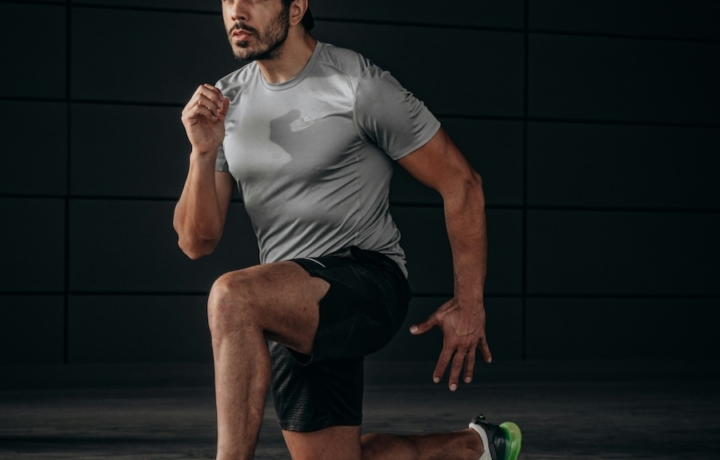Exercise
Roll Lower Back (Side) Lying On Floor

Roll Lower Back (Side) Lying On Floor
How to Perform
- Lie on your side on a floor mat with your knees bent at approximately 90 degrees and your arms extended in front of your chest for balance.
- Stack your hips, shoulders, and ankles in a straight line, keeping your head neutrally aligned with your spine.
- Engage your core by drawing your navel toward your spine while maintaining a natural curve in your lower back.
- Inhale to prepare, then exhale as you slowly roll your pelvis and lower back backward, creating a slight rotation in your spine.
- Control the movement using your obliques and deep core muscles, ensuring your shoulders remain relatively stable.
- Roll only as far as you can maintain proper form, focusing on the articulation of each vertebra rather than the range of motion.
- Inhale as you pause briefly at the end range, then exhale as you return to the starting position with control.
- Perform all repetitions on one side before switching to the opposite side, maintaining consistent breathing throughout.
Important information
- Keep your top shoulder from collapsing forward during the movement to prevent excessive thoracic rotation.
- If you feel any pinching in your lower back, reduce the range of motion and focus on more subtle movements.
- Place a small folded towel under your waist if you feel discomfort in your bottom hip bone.
- Ensure you're moving from your core and not just swinging your legs to generate momentum.

Roll Lower Back (Side) Lying On Floor
Exercise Details
Primary Muscles
Muscle Groups
Mechanic
Risk Areas
Built for progress
Take the guesswork out of training
Create personalized AI-powered workout plans that evolve with you. Train smarter, track every rep and keep moving forward, one workout at a time.






The Roll Lower Back (Side) exercise performed while lying on the floor offers a gentle yet effective way to release tension in the erector spinae muscles and engage the abdominal region. As a beginner-friendly mobility technique, this movement serves as an excellent addition to your recovery protocols, cool-down routines, or as part of a comprehensive warm-up sequence. This subtle rolling motion targets the often-neglected muscles that run alongside your spine, which can become tight and restricted from prolonged sitting or repetitive activities. The beauty of this exercise lies in its simplicity: it requires no equipment, just your body and a comfortable floor space, making it accessible regardless of your fitness environment. When incorporated into your recovery sessions, the Roll Lower Back (Side) can help alleviate discomfort and stiffness that accumulates throughout the day. The gentle movement promotes blood flow to the lower back region, potentially accelerating muscle repair and reducing post-exercise soreness.
Many fitness enthusiasts find this technique particularly soothing after lower-body strength training or endurance activities. As a stretching modality, this exercise creates subtle traction along the spine while encouraging rotation through the torso, improving overall spinal mobility. The controlled movement pattern helps to reset your posture by releasing muscle tension patterns that may have developed during your daily activities or workout. What makes this exercise particularly valuable is its dual action of stretching tight muscles while simultaneously activating core stabilizers. This combination supports better movement quality and body awareness, which translates to improved performance in more complex exercises.
The gentle nature of the movement also makes it appropriate for those managing minor back discomfort under proper professional guidance. Remember that consistency with mobility work often yields better results than intensity. Incorporating this Roll Lower Back (Side) technique regularly into your fitness routine can contribute to long-term spinal health and movement quality, supporting your overall athletic development and daily comfort.
FAQ - Roll Lower Back (Side) Lying On Floor
This exercise primarily targets the erector spinae muscles that run alongside your spine while engaging your core stabilizers and obliques. The gentle rolling motion also helps release tension in the quadratus lumborum and promotes mobility through the thoracolumbar fascia.
You can safely perform this exercise 3-4 times weekly, either as part of your warm-up or cool-down routine. It's particularly beneficial after intense upper body training sessions or on recovery days to maintain shoulder health and function.
This gentle mobility exercise is generally safe for those with minor back discomfort, but always move within a pain-free range. If you have diagnosed back conditions, herniated discs, or acute pain, consult with a healthcare professional before attempting this or any back exercise.
The most common mistakes include rushing through the movement, using momentum instead of controlled motion, and forcing rotation beyond your comfortable range. Keep the movement slow and deliberate, breathe throughout the exercise, and never push through sharp or shooting pain.
To increase the intensity, extend your arms further from your body to create a longer lever or hold briefly at points of tightness. For a gentler approach, keep your knees more bent and arms closer to your body, or place a small pillow under your head for neck support.







